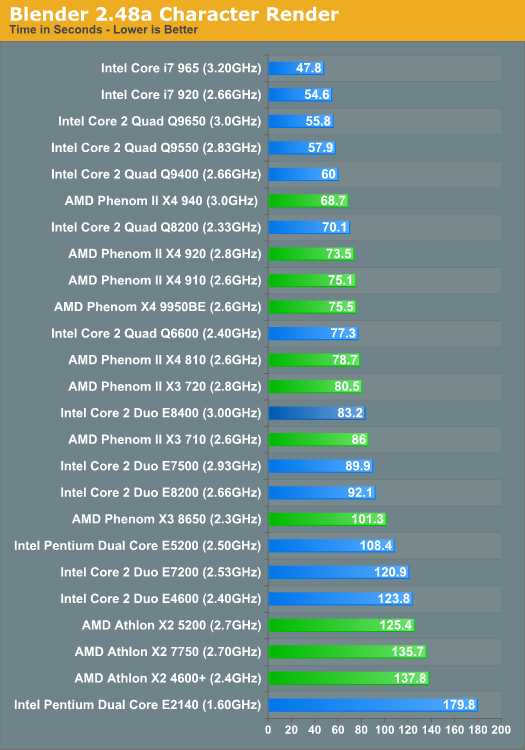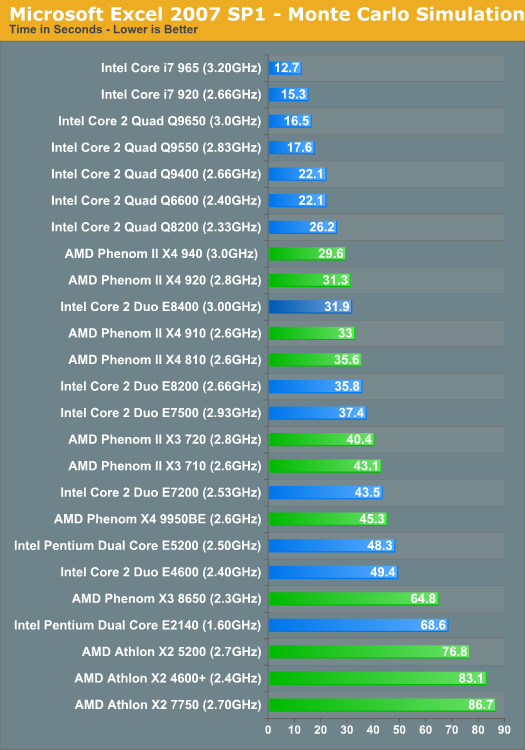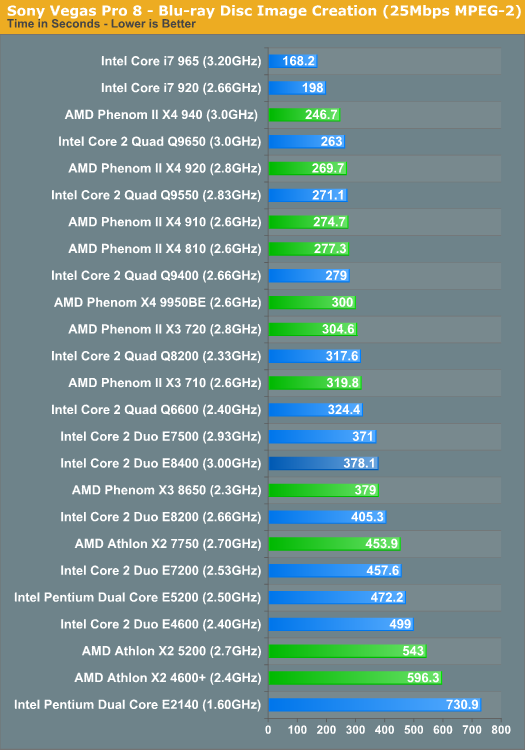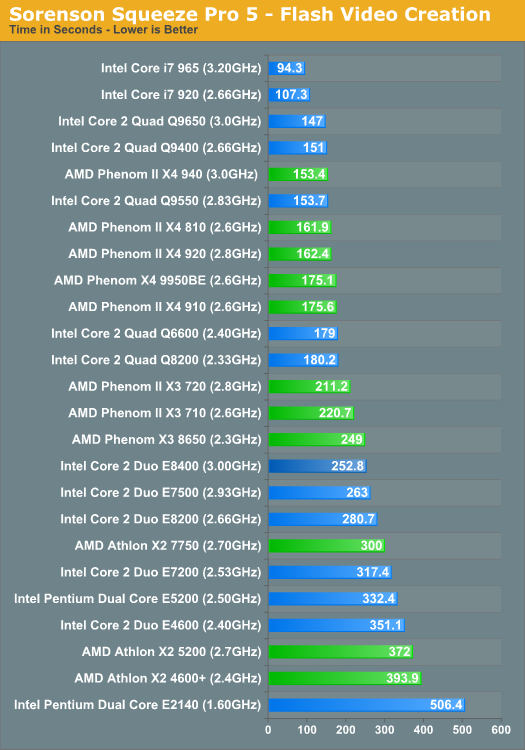The Phenom II X4 810 & X3 720: AMD Gets DDR3 But Doesn't Need It
by Anand Lal Shimpi on February 9, 2009 12:00 AM EST- Posted in
- CPUs
Blender 2.48a
Blender is an open source 3D modeling application. Our benchmark here simply times how long it takes to render a character that comes with the application.

While AMD is competitive in many applications, some do favor Intel's architectures; Blender is one of them. Only the Phenom II 700 series is competitive thanks to its triple-core advantage.
Microsoft Excel 2007
Excel can be a very powerful mathematical tool. In this benchmark we're running a Monte Carlo simulation on a very large spreadsheet of stock pricing data.

Sony Vegas Pro 8: Blu-ray Disc Creation
Although technically a test simulating the creation of a Blu-ray disc, the majority of the time in our Sony Vegas Pro benchmark is spend encoding the 25Mbps MPEG-2 video stream and not actually creating the Blu-ray disc itself.

AMD is very competitive here, outperforming all of the equivalently priced Intel CPUs. The clock speed and cache advantage of the Phenom II X3 720 is enough to even outpace the Core 2 Quad Q8200.
Sorenson Squeeze: FLV Creation
Another video related benchmark, we're using Sorenson Squeeze to convert regular videos into Flash videos for use on websites.

The performance breakdown is more of what we've been seeing here tonight.
WinRAR - Archive Creation
Our WinRAR test simply takes 300MB of files and compresses them into a single RAR archive using the application's default settings. We're not doing anything exotic here, just looking at the impact of CPU performance on creating an archive:

The entire Phenom II lineup ends up performing very similarly, largely because there are IO limitations at work here despite our use of an SSD. Cache size matters as Intel's smaller cache quad-core chips don't do nearly as well as the 12MB behemoths.










77 Comments
View All Comments
7Enigma - Monday, February 9, 2009 - link
Ditto the power consumption at OC'd levels. I always get annoyed to see these fantastic OC results but then fail to see whether we've doubled the power consumption. It would certainly allow us to see a potential benefit if one or the other uses significantly less power under OC load conditions.Gary Key - Monday, February 9, 2009 - link
We will have power consumption and temps up tomorrow for the OC results along with a few benchmarks. It was difficult to get stable (true) volt readings with the X4 810 installed, so I spent my weekend with the DMM on the boards.Kaleid - Monday, February 9, 2009 - link
Great! Possible to also add difference with non-overclocked and overclocked power consumption at idle?7Enigma - Monday, February 9, 2009 - link
At the wall (total system) or just for the CPU? Do you mean the total system power was fluctuating with the 810? That seems really really wierd.Gary Key - Monday, February 9, 2009 - link
The power was fluctuating on the board at the Core VID side. I should have a BIOS spin tonight to fix it. The 720 was perfect but the 810 had a few problems that have been identified now.7Enigma - Monday, February 9, 2009 - link
*weird, please give us an edit function.OCedHrt - Monday, February 9, 2009 - link
Interestingly, the 810 vs 910, there is no real performance difference outside the margin of error. In some cases, the 810 is faster and in some, the 910 takes the lead. Something I noticed though is that the 810 is faster than the 910 at more times, and faster by a larger amount (~3% when it is faster) as well. Seems like the reduced cache does not actually hamper performance.Moorbo - Friday, April 24, 2009 - link
For most applications it seems you're correct that the smaller cache makes little difference. However if you look at the gaming performance the 2MB/core L3 cache of the 720 and 710 clearly makes a big difference despite their slower clock and lack of an additional core. What would the numbers look like with only two cores and 3MB/core and a higher clock?johnsonx - Monday, February 9, 2009 - link
indeed, the 710 is also often faster than the 910, but usually slower than the 810.I'm a bit surprised we the readers have to thumb through all the benchmark charts to see the 710/810/910 comparison. 3 Phenom II's at the same speed, one 'standard', one with less cache and one with a missing core; that is something AT should have dedicated a page to.
stmok - Monday, February 9, 2009 - link
Yeah, I noticed that as well. It looks like 4MB L3 cache is sufficient with Phenom II. (Any less, it'll start hurting...Any more, you're just wasting silicon space).